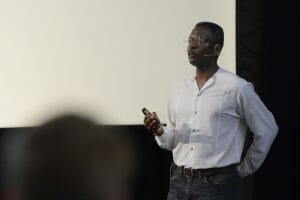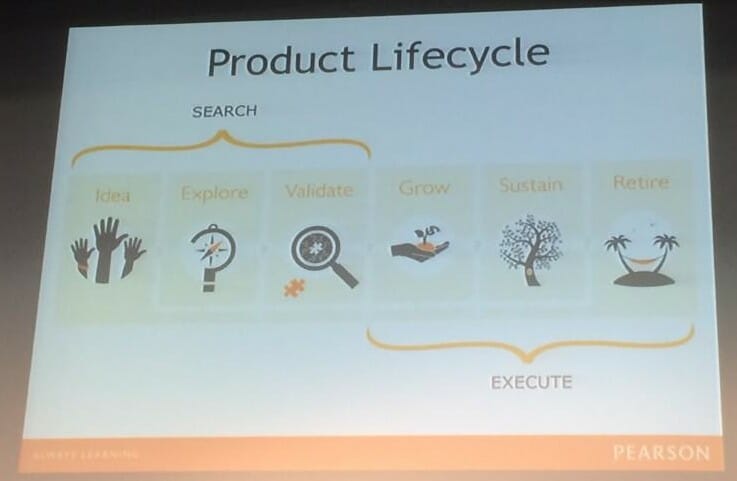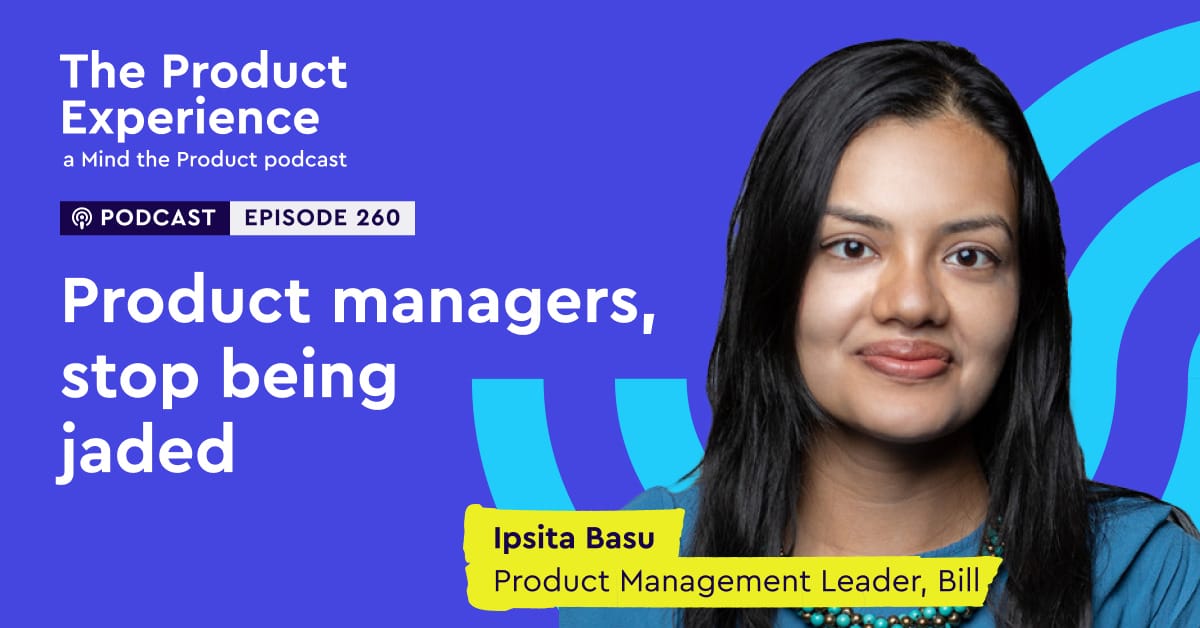Some people say that a change is as good as a rest. They’ve probably never had to change an organisation’s product culture, though. For July’s ProductTank London, Marc Abraham (@MAA1) brought us three experts in making change happen.
- Derek Morrison (@allaboutproduct), Group Product Manager at Tesco
- Sally Foote (@sallyfoote), Digital Product Consultant, Founder of FEB Digital
- Craig Strong (@craigstrong), Director Global Product Development Lifecycle at Pearson
The Pursuit of Product Happiness
 Derek Morrison (@allaboutproduct) took the stage first to talk about some of his lessons learned from introducing changes to product development at organisations such as Reed Business Management (RBM), Tesco and Blinkbox Books.
Derek Morrison (@allaboutproduct) took the stage first to talk about some of his lessons learned from introducing changes to product development at organisations such as Reed Business Management (RBM), Tesco and Blinkbox Books.
In 2004 RBM saw that its revenue was beginning to shift more towards online products. In response it centralised all its developers into the same department and hiring product managers to be the interface between the business and the development team.
Initially RBM’s product team started out with a document-laden and inward-looking Waterfall process, but found this resulted in poor quality and late-shipping products. The product managers ended up stuck in between a frustrated business and dissatisfied developers.
So RBM replaced Waterfall with Agile across the whole organisation, from the development teams to the board of directors. It was important that everyone bought into the new way of doing things and wanted to change, so they also used external Agile coaches. Scrum allowed them to surface and resolve otherwise hidden problems, and in turn to take better quality products to market more quickly.
When Tesco needed to change its product practices to become more data-driven and customer-centric, it took an iterative approach to defining the right product process. The product team would start by sketching out the new process, showing it to key stakeholders, listening to feedback and tweaking until it really meshed with the organisation’s needs and people were demanding to adopt the new process.
Lessons Learned
- Demonstrate the benefits of change with data. At RBM, Derek found that its original Waterfall process forced the product team to focus on firefighting and tended to overload the people available. He was able to use evidence of that his team was spending its time mostly on tactical activities to lobby senior management for the product team to grow in step with the development team, meaning the team could focus more of its on strategy.
- Don’t just copy other people’s process. Blinkbox Books copied a successful Kanban development process from its sister company Blinkbox Movies, but found it didn’t work for them because their organisational needs were different.
- Take people with you. When making a change, start small by working on a one-to-one basis with a selection of people from different disciplines, listen and learn from them, then grow outwards from there.
How to Take Your Company with You through a Big Product Pivot
 Sally Foote (@sallyfoote) was on next to speak of her experiences at News UK when in 2009 it introduced a paywall to its online versions of the Times and Sunday Times newspapers.
Sally Foote (@sallyfoote) was on next to speak of her experiences at News UK when in 2009 it introduced a paywall to its online versions of the Times and Sunday Times newspapers.
It can be hard to change products, particularly when so many people are emotionally invested in them. It’s like trying to convince someone to change their allegiance to a football team. Charging subscription fees to access the content was just as a huge a cultural change.
This shift affected all products, all the staff and all the measures for success. Four or five years later, the decision to change has been vindicated, but in the beginning many opposed the idea, not least journalists such as Caitlin Moran who gleefully tweet to readers whenever the paywall temporarily goes down.
News UK did four things to take them through this journey:
- Showing the working. News UK had found that a purely advertising-funded model would not generate sufficient revenue; that readers often read one article and never came back; and that the difficulty of predicting traffic spikes made them almost impossible to exploit for advertising revenue. Explaining these reasons made it clear why the business model had to change.
- Having a clear vision. Senior management dictated that customers were going to pay for digital content. This bold statement set the boundaries for people at News UK – whether or not they agreed with it. A good company vision statement is broad enough to allow products the flexibility to change as needed, as when Netflix pivoted from a postal to a streaming service. However, a vision should not be meaninglessly general, nor lock the company into specific technologies. It also needs to be concise and memorable for people, which you can test.
- Changing the measures. The paywall changed the measures from volume to value. Subscribers could have a more valuable experience, not just through the content but through other more direct interactions with journalists. This shift also meant that when traffic volume inevitably went down with the introduction of the paywall, it was neither a surprise nor a cause for concern.
- Communicating effectively. Senior management at News UK talked openly about all of the above, why the decision to change was made, what the vision was to be and how success would be measured. You should find a leader to spearhead the change. Staff at News UK may not have all initially agreed with the introduction of the paywall, but they were willing to follow the lead of James Harding, the editor at the time. Reinforce the vision with compelling storytelling, such as videos of what future subscribers would look like.
And while all this change was going on, they tried to have fun. The product team at News UK had I ♥ PAYWALLS built in Lego and an Arduino-driven bell that rang every time a new subscriber joined, both of which also served as reminders to reinforce the change.
Above all, remember that you’re not going to change someone’s mind about something in which they passionately believe – like the football team they support – in the space of fifteen minutes. Change takes time.
Changing a Global Product Culture
 Pearson is at an early stage of transforming its business. With an ecosystem of 250 digital products and 44,000 employees operating in 70 countries, change is no straightforward task. Craig Strong (@craigstrong) took us through what he’s learned so far.
Pearson is at an early stage of transforming its business. With an ecosystem of 250 digital products and 44,000 employees operating in 70 countries, change is no straightforward task. Craig Strong (@craigstrong) took us through what he’s learned so far.
At the core of this cultural change is the adoption of a new product lifecycle that places the customer – the learner – and iterative practices at the centre. Every product decision has to demonstrate that it will drive learning outcomes.

Ideas can come from anyone, anywhere to encourage innovation. This in itself is a complete cultural change for the company. Assuming the idea is aligned with the company strategy, the next step is not to think about the solution, but to get out of the building to explore and understand the customer need. Then a potential solution is validated before being put into production.
It’s worth noting that there’s a large difference between the process of searching for problems and solutions, and delivering (executing) a product. You need to use different and appropriate methodologies for each scenario.
In his article Change or Die, Alan Deutschman found that 90 percent of people still will not change their behaviour even when faced with a mortality decision. You can assume that 90 percent of your own organisation will be similarly resistant to change – that’s your challenge.
Lessons Learned
- Support for change is not enough. You need action, led from senior management, and for that action to be seen to inspire support for the change. Inspiration is key – people don’t change purely based on the “what” they need the “why” also.
- Change has a lifecycle. It’s much like the iterative product lifecycle above, customer-centred and evidence-led.
- Celebrate success to-date. It helps to maintain motivation particularly in teams close to the changes.
- Don’t drink your own Kool-Aid. It’s very easy to alienate people when you’re passionate about something, which can create cliques or cults in which one group points to another and tells them they’re doing it wrong.
- Don’t be afraid to say you don’t know. You won’t have all the answers, so remember that listening equals learning.
- Be wary of frameworks. By definition you can’t confine a continual improvement process to a fixed framework.
- Find the person people will listen to. Don’t take it personally if you find that people will listen to certain people and not you. Sometimes another voice – perhaps from outside the organisation – is needed to inspire others and implant an idea.
- Shift to outcomes over outputs. Outcomes give people the flexibility to change their work approach to deliver the outcomes, rather than locking them in to specific outputs.
- Celebrate failure, but fail elegantly. It may not be the best idea to go around shouting, “We failed!”. You may instead wish to think about learning fast versus failing fast. Set up an environment in which you can fail safely and can demonstrate why you failed, what you learned, and how much you saved the company by stopping, then move on to explore the next product idea.
- Give people the confidence to change. Protect people from the risks of change by letting them take the credit for successes, but you take the blame for failures.
- Share knowledge. Let others learn from what worked, what didn’t.
- Become multilingual. Speak the language of your audience and speak about what matters to them, not what you happen to be most passionate about.
- Communities are assets. Training gives people the initial ability to get started, but a community can be a source of knowledge and inspiration for others to make and persist with the change.
- Solve customer problems. Don’t just build things, understand the problem and its context. The answers are all outside of the office so get out there.
- Beware of projects. Projects are set up with fixed start and end points, often prioritise output over outcomes, and so fail to solve the underlying problem.
- Cross-functional teams are key. They’re powerful not just for building the product, but for bringing all departments into a product culture. Hire in priority of beliefs (hard to change), then capabilities, then skills (can be learnt).
Lastly, remember that the road ahead for change is long and twisty. Don’t plan for it being short and straight.
Thanks
We’re terribly grateful to Tesco for sponsoring July’s ProductTank on change management.
Do join us for our next ProductTank London. Tickets will be available shortly (join the waitlist if none are currently available).
Tickets are also selling fast for 2014’s Mind The Product Conference on 11th / 12th September, as well as the hands-on workshops. Get yours now!
You can also get in touch with us if you’re interested in speaking at or curating a ProductTank, writing for our blog on Mind The Product, or sponsoring our events. See you soon!








Comments 1